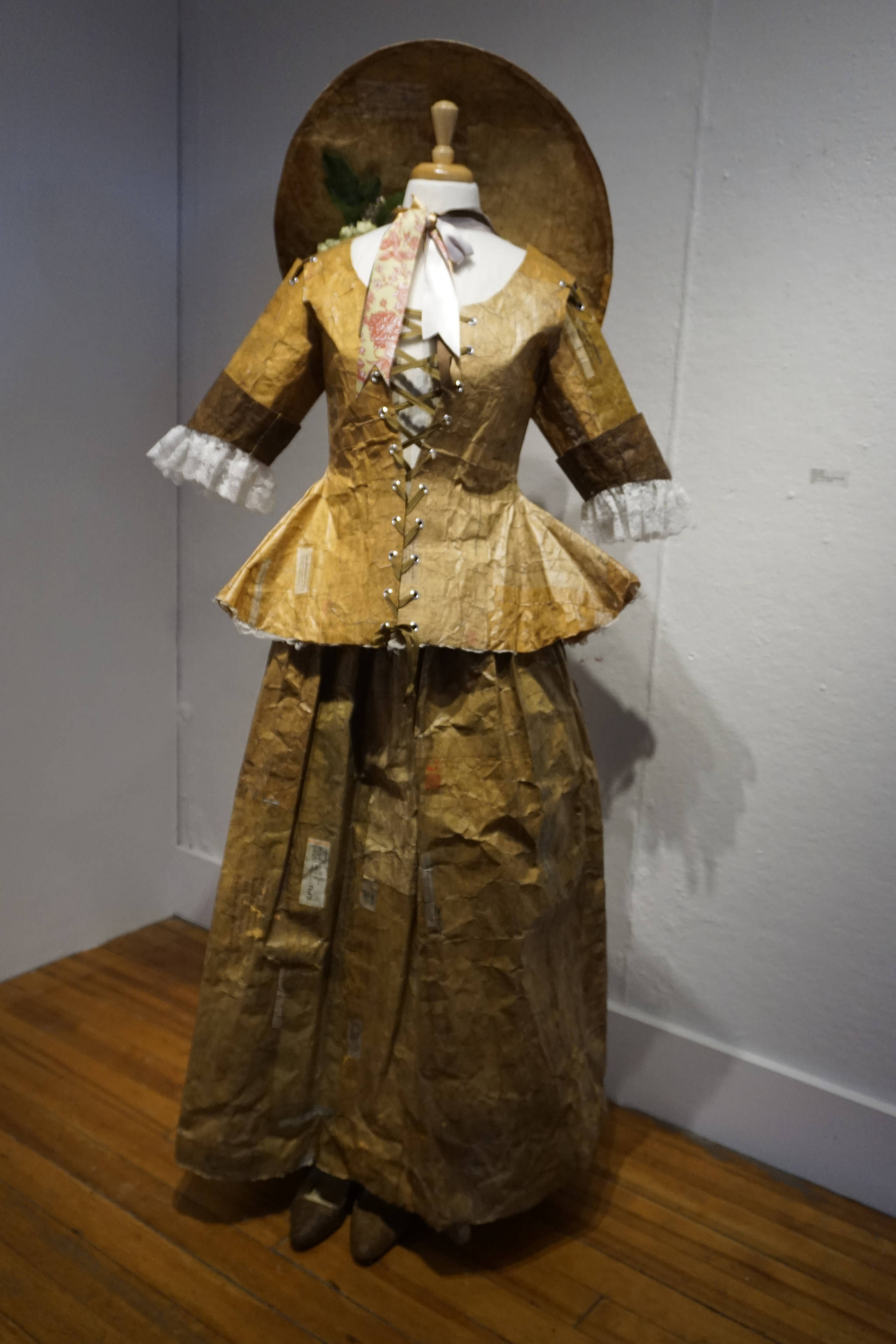Through its ongoing collaborations with the Homer Fiber Arts Collective, Bunnell Street Arts Center has pushed the boundaries of wearable art. This month’s exhibit by Anchorage textile artist and artist-in-residence Keren Lowell slams the idea into warp drive and takes the concept where few have gone before.
Bunnell has featured fiber and textile artists before, such as the inspired and meticulous work by Anchorage artist Amy Meissner or Homer artist Abigail Kokai. Last year’s Homer Fiber Arts Collective artist-in-residence Sheila Wyne has some of the punk sensibility of Lowell. They’re both starship captains cruising the same edgy dimensions of art.
Lowell’s work combines the best of those textile artists by creating two-dimensional tapestries — three-dimensional, actually, when you look at its rich texture — along with fiber art that is couture or fashion. In a way, Lowell’s garments essentially wrap textile art around the human body.
“Some of it is architecture,” Lowell said of her garments in her artist’s talk last Friday at the Oct. 6 opening of her Bunnell show. “The body is a moving sculpture when we wear this. They’re flexible surfaces, but two-dimensional.”
Like Wyne’s visit last year, Lowell conducts workshops in preparation for the Homer Fiber Arts Collective’s annual Wearable Arts show, to be held 6 and 9 p.m. Nov. 17 at Land’s End Resort. This year’s theme is “Time Traveling,” and includes a retrospective look at earlier Wearable Arts show. Tickets are $25, on sale at Bunnell. The deadline for submitting work is Nov. 10.
From 7-9 p.m. Friday, Oct. 12, 19 and 26, Lowell offers free, open-sew sessions where artists can come and work on projects, get advice and share ideas.
From noon to 4 p.m. Saturday and Sunday, Oct. 13, 14, 20, 21, 27, 28, and Nov. 3 and 4, Lowell also offers sewing and construction workshops. Classes are $25 each, $40 a weekend or $150 for all weekends. See https://www.bunnellarts.org/keren-lowell-october-2018 for class descriptions.
According to her website, www.kerenlowell.com, Lowell grew up in Colorado on the western slope, graduating from high school in Delta. She graduated with a bachelor or arts in interdisciplinary studies from the University of Northern Colorado in Greeley, studying 20th century visual arts, music and poetry.
After college she worked as an artist in St. Paul, Minnesota, and McComb, Mississippi, before moving to Chicago to attend graduate school at the Art Institute of Chicago, where she graduated in 1992 with a master of fine arts in fiber. She moved to Alaska in 1994, teaching art and humanities at the University of Alaska Fairbanks. In 2000 she moved to Anchorage, teaching fiber arts at the Matanuska-Susitna Campus of the University of Alaska Anchorage and later at the UAA main campus, where she ran the Fiber Department. She now works at the Alaska State Council on the Arts, coordinating office activities, travel and events.
Some of Lowell’s Bunnell pieces come out of her arts council work — that is, as raw material. She handles a lot of manila envelopes and collected them to make two pieces, the garment, “Work Dress,” and a large tapestry, “Groundwork.” The stiff, bland paper has been crumpled, colored and altered into something resembling leather. Labels and clasps can still be seen in the fabric.
At her artist’s talk last Friday, Lowell said she starts with material and an idea.
“The challenge is to let that happen and bring the material into the conversation I want to have,” she said. “…I work rough and ready, but at the same time, I’m particular.”
“Work Dress” is a play on the idea of modern work — the institutional, functional fabric of manila envelopes — with the form of a historically accurate 18th century woman laborer’s dress.
“I thought it was cheeky,” Lowell said.
Her Bunnell show includes seven garments, all done for Anchorage wearable arts shows. The titles of some come from poems, like the creepy, slightly horrifying “Rough Beast,” a reference to William Butler Yeats’ “Second Coming” and its closing lines “And what rough beast, its hour come round at last / slouches its way to Bethlehem to be born?”
“Rough Beast” includes human and animal hair, bone, cotton and pigment. The helmet is made of gauze, plaster of Paris and diamond mesh, as is the chest plate of another poetically-titled work, “Ozymandias.” Diamond mesh is a sculptural medium that can be stretched to a shape and then slathered with gauze and plaster of Paris. “Rough Beast” looks like a fur-encrusted ghillie suit, the military camouflage outfits that resemble bushes.
Two works demonstrate Lowell’s fascination with repairing the broken. “Worry Coat” contains found objects treated like fetishes and little medicine pouches all incorporated in a garment with stitched tears. “Ric-rac Potluck Tunic” pieces together long bits of ric-rac that look like they might have been taken from the hems of kuspuks.
“Mending is a big part of my ethos,” Lowell said. “… I like the aesthetic of the rip.”
Damage also becomes part of her art. One piece consists of placeholder text called Greeking photocopied and assembled in layers. Held together with gel medium, whenever Lowell shows the work, rolls it up, and then unrolls it to show again, bits drop off that she has to repair.
“Every exhibit the white patches get bigger and bigger,” she said.
Lowell said she appreciates the opportunity to work with Homer’s fiber artists.
“That’s the great thing about the textile community,” she said. “It’s collaborative.”
Reach Michael Armstrong at marmstrong@homernews.com.


